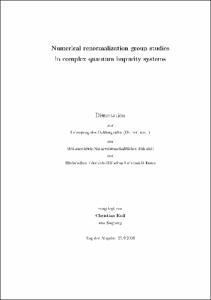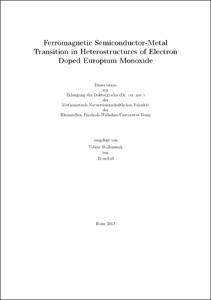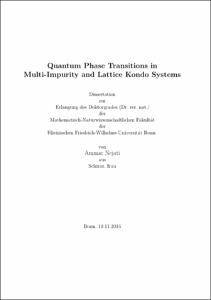Dynamical Effects in Heavy-Fermion Systems

Dynamical Effects in Heavy-Fermion Systems

| dc.contributor.advisor | Kroha, Johann | |
| dc.contributor.author | Lenk, Marvin | |
| dc.date.accessioned | 2025-03-27T09:19:23Z | |
| dc.date.available | 2025-03-27T09:19:23Z | |
| dc.date.issued | 27.03.2025 | |
| dc.identifier.uri | https://hdl.handle.net/20.500.11811/12967 | |
| dc.description.abstract | When atoms in solids have unfilled d- or f-orbitals, local Coulomb interaction often becomes non-negligible due to the strongly localized nature of those orbitals. A hallmark effect of such systems is the formation of a set of localized states at the Fermi energy due to the local nature of the Kondo effect. If the so-formed Kondo singlets become lattice coherent, a heavy Fermi liquid is formed. A long-standing open question is the fate of individual crystal (electric) field (CEF) states involved in this process. Lattice coherence of different CEF states could, in principle, occur at different temperatures and extents. This is the case in YbRh2Si2, for which scanning tunneling microscopy (STM) revealed a puzzling picture. The Kondo effect leads to a dip in the STM spectrum. Below temperatures where the dip was already clearly pronounced, a peak close to the minimum of the dip arose, which was attributed to the formation of lattice coherence. Simultaneously, additional peaks at the CEF energies arose, hinting towards lattice coherence in all states. In this thesis, I present a comprehensive overview of lattice coherence in heavy fermion systems, from the basics of quantum particles in periodic potentials to methods for interacting systems and how to modify them to include CEF states and methods for solving such systems with quantum field theory and numerically. I construct a minimalistic model for YbRh2Si2, including all four CEF states of the Yb3+ 4f13 configuration. With this, I present results confirming the observed behavior qualitatively. The Kondo dip and the coherence peak are reproduced faithfully. The first excited CEF level shows clear signs of lattice coherence, and higher excited CEF states show weaker signs of coherence. The non-Fermi liquid behavior in two-channel Kondo heavy-fermion systems is explored as a second topic. Intriguingly, such behavior was experimentally observed in PrV2Al20, whereas PrTi2Al20 showed regular heavy Fermi liquid behavior. It was proposed that the former sits closer to a putative quantum-critical point. While this could explain the observed behavior, another possible explanation can be formulated. The two-channel Kondo effect gives rise to a local non-Fermi liquid behavior. If this picture translates to the lattice case, it could fully explain the experimentally observed scaling. This option is explored as the second main subject of this thesis. I present a model incorporating the relevant CEF states of the Pr3+ 4f2 configuration and using ab initio band structure data. While including only the CEF ground state already leads to non-Fermi liquid behavior in the lattice model, the stark deviation from the experimentally observed magnetic susceptibility necessitates the inclusion of the first excited CEF state as well. This is shown to improve the scale of the onset of non-Fermi liquid behavior and reproduce the qualitatively correct scaling of the magnetic susceptibility, confirming the alternative explanation for the experimentally observed behavior. | en |
| dc.language.iso | eng | |
| dc.rights | Namensnennung 4.0 International | |
| dc.rights.uri | http://creativecommons.org/licenses/by/4.0/ | |
| dc.subject | Theorie der kondensierten Materie | |
| dc.subject | kondensierte Materie | |
| dc.subject | Kondo-Effekt | |
| dc.subject | Kondo-Gitter | |
| dc.subject | Hilfsteilchen | |
| dc.subject | Schwerfermionen | |
| dc.subject | Schwerfermionsysteme | |
| dc.subject | Kristallfelder | |
| dc.subject | Kristallfeldzustände | |
| dc.subject | Kristallfeldaufspaltung | |
| dc.subject | Gitterkohärenz | |
| dc.subject | Nicht-Fermiflüssigkeit | |
| dc.subject | Periodisches Andersonmodell | |
| dc.subject | Zweikanal-Kondo-Effekt | |
| dc.subject | condensed matter theory | |
| dc.subject | condensed matter | |
| dc.subject | Kondo effect | |
| dc.subject | Kondo lattice | |
| dc.subject | auxiliary particles | |
| dc.subject | non-crossing approximation | |
| dc.subject | heavy fermions | |
| dc.subject | heavy-fermion systems | |
| dc.subject | crystal fields | |
| dc.subject | crystal field states | |
| dc.subject | crystal field splitting | |
| dc.subject | lattice coherence | |
| dc.subject | non-Fermi liquid | |
| dc.subject | periodic Anderson model | |
| dc.subject | two-channel Kondo effect | |
| dc.subject.ddc | 530 Physik | |
| dc.title | Dynamical Effects in Heavy-Fermion Systems | |
| dc.type | Dissertation oder Habilitation | |
| dc.identifier.doi | https://doi.org/10.48565/bonndoc-536 | |
| dc.publisher.name | Universitäts- und Landesbibliothek Bonn | |
| dc.publisher.location | Bonn | |
| dc.rights.accessRights | openAccess | |
| dc.identifier.urn | https://nbn-resolving.org/urn:nbn:de:hbz:5-81999 | |
| ulbbn.pubtype | Erstveröffentlichung | |
| ulbbnediss.affiliation.name | Rheinische Friedrich-Wilhelms-Universität Bonn | |
| ulbbnediss.affiliation.location | Bonn | |
| ulbbnediss.thesis.level | Dissertation | |
| ulbbnediss.dissID | 8199 | |
| ulbbnediss.date.accepted | 18.09.2024 | |
| ulbbnediss.institute | Mathematisch-Naturwissenschaftliche Fakultät : Fachgruppe Physik/Astronomie / Physikalisches Institut (PI) | |
| ulbbnediss.fakultaet | Mathematisch-Naturwissenschaftliche Fakultät | |
| dc.contributor.coReferee | Trebst, Simon | |
| ulbbnediss.contributor.orcid | https://orcid.org/0009-0000-9844-2103 |
Dateien zu dieser Ressource
Das Dokument erscheint in:
-
E-Dissertationen (4424)







